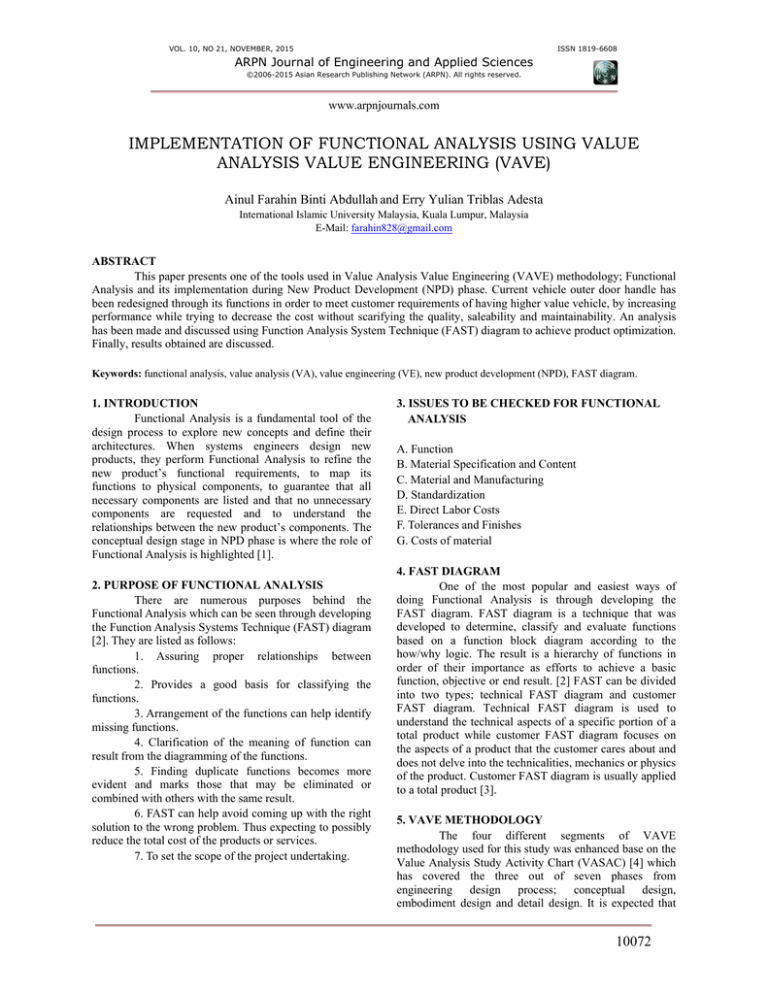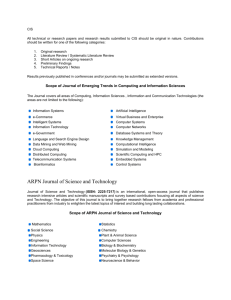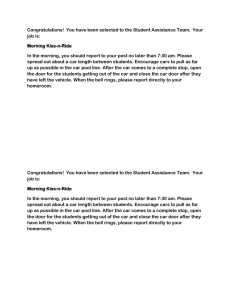
VOL. 10, NO 21, NOVEMBER, 2015
ISSN 1819-6608
ARPN Journal of Engineering and Applied Sciences
©2006-2015 Asian Research Publishing Network (ARPN). All rights reserved.
www.arpnjournals.com
IMPLEMENTATION OF FUNCTIONAL ANALYSIS USING VALUE
ANALYSIS VALUE ENGINEERING (VAVE)
Ainul Farahin Binti Abdullah and Erry Yulian Triblas Adesta
International Islamic University Malaysia, Kuala Lumpur, Malaysia
E-Mail: farahin828@gmail.com
ABSTRACT
This paper presents one of the tools used in Value Analysis Value Engineering (VAVE) methodology; Functional
Analysis and its implementation during New Product Development (NPD) phase. Current vehicle outer door handle has
been redesigned through its functions in order to meet customer requirements of having higher value vehicle, by increasing
performance while trying to decrease the cost without scarifying the quality, saleability and maintainability. An analysis
has been made and discussed using Function Analysis System Technique (FAST) diagram to achieve product optimization.
Finally, results obtained are discussed.
Keywords: functional analysis, value analysis (VA), value engineering (VE), new product development (NPD), FAST diagram.
1. INTRODUCTION
Functional Analysis is a fundamental tool of the
design process to explore new concepts and define their
architectures. When systems engineers design new
products, they perform Functional Analysis to refine the
new product’s functional requirements, to map its
functions to physical components, to guarantee that all
necessary components are listed and that no unnecessary
components are requested and to understand the
relationships between the new product’s components. The
conceptual design stage in NPD phase is where the role of
Functional Analysis is highlighted [1].
2. PURPOSE OF FUNCTIONAL ANALYSIS
There are numerous purposes behind the
Functional Analysis which can be seen through developing
the Function Analysis Systems Technique (FAST) diagram
[2]. They are listed as follows:
1. Assuring proper relationships between
functions.
2. Provides a good basis for classifying the
functions.
3. Arrangement of the functions can help identify
missing functions.
4. Clarification of the meaning of function can
result from the diagramming of the functions.
5. Finding duplicate functions becomes more
evident and marks those that may be eliminated or
combined with others with the same result.
6. FAST can help avoid coming up with the right
solution to the wrong problem. Thus expecting to possibly
reduce the total cost of the products or services.
7. To set the scope of the project undertaking.
3. ISSUES TO BE CHECKED FOR FUNCTIONAL
ANALYSIS
A. Function
B. Material Specification and Content
C. Material and Manufacturing
D. Standardization
E. Direct Labor Costs
F. Tolerances and Finishes
G. Costs of material
4. FAST DIAGRAM
One of the most popular and easiest ways of
doing Functional Analysis is through developing the
FAST diagram. FAST diagram is a technique that was
developed to determine, classify and evaluate functions
based on a function block diagram according to the
how/why logic. The result is a hierarchy of functions in
order of their importance as efforts to achieve a basic
function, objective or end result. [2] FAST can be divided
into two types; technical FAST diagram and customer
FAST diagram. Technical FAST diagram is used to
understand the technical aspects of a specific portion of a
total product while customer FAST diagram focuses on
the aspects of a product that the customer cares about and
does not delve into the technicalities, mechanics or physics
of the product. Customer FAST diagram is usually applied
to a total product [3].
5. VAVE METHODOLOGY
The four different segments of VAVE
methodology used for this study was enhanced base on the
Value Analysis Study Activity Chart (VASAC) [4] which
has covered the three out of seven phases from
engineering design process; conceptual design,
embodiment design and detail design. It is expected that
10072
VOL. 10, NO 21, NOVEMBER, 2015
ISSN 1819-6608
ARPN Journal of Engineering and Applied Sciences
©2006-2015 Asian Research Publishing Network (ARPN). All rights reserved.
www.arpnjournals.com
the existing vehicle outer door handle especially for the 3door hatchback car can be redesigned base on this
methodology. The first two segments were covering the
first phase of engineering design process.
5.4. Segment 3
Segment 3 is covering the detail design phase of
engineering design process. The alternatives need to be
further reviewed based on the cost. Current alternative
designs cost need to be compared with the previous target
cost in segment 1. The final steps from Value Analysis
need to be made before the alternatives can be resolved to
select and propose for the best model. Selected best model
may then be validated before the results can be presented
and published.
Figure-2. An overview of the VAVE methodology
flowchart.
Figure-1. Discrete steps in engineering design process
from problem definition to detail design. The chief tools or
techniques applicable in each step are given [5].
5.1. Preparation
Data was collected through set of questionnaire
done by the previous study regarding PROTON cars
which has taken public as the respondents.
5.2. Segment 1
FAST diagrams were developed base on the
function analysis made as to come out with a new target
cost. Then, data may be collected from the benchmarking
and observations for the new concept generation and
selection. At the end of segment 1, feasible design can be
generated. However this case study only focuses up to the
FAST diagram as to show how it can be developed and
what are the benefits through this methodology.
6. CASE STUDY - VEHICLE OUTER DOOR
HANDLE
The company Perusahaan Otomobil Nasional
(National Automotive Industry) PROTON is selected for
the case study, located in Shah Alam, Selangor, Malaysia.
Establish in 1983, PROTON is Malaysia’s largest
manufacturer of automobiles, and the only full-fledged
OEM car manufacturer in Southeast Asia. Its key markets
are from the United Kingdom to the Middle East and
across South-East Asia and Australia - especially in
countries like China, India and Iran - PROTON produces
cars to suit a range of customer demands and preferences.
It offerings include versatile and reliable four-door family
vehicles, two-door hatchbacks for the young-at-heart,
luxurious and stylish executive sedans, spacious and
affordable multi-purpose vehicles, as well as the world
renowned sports cars from Lotus. Most importantly,
PROTON models are now developed with Lotus
Engineering, offering customers a superior ride and
handling experience [6], Hence, this study has applied the
Functional Analysis tool to the product manufactured in
this industry.
5.3. Segment 2
Segment 2 is covering the next phase of
engineering design process; embodiment design. From the
feasible design generated in segment 1, several
alternatives can be introduced. These alternatives can be
developed through modelling and prototyping. They may
then been critiqued based on the Design for Manufacturing
and Assembly (DFMA) guidelines as to come out with
few feasible models.
Figure-3. Current vehicle outer door handle.
10073
VOL. 10, NO 21, NOVEMBER, 2015
ISSN 1819-6608
ARPN Journal of Engineering and Applied Sciences
©2006-2015 Asian Research Publishing Network (ARPN). All rights reserved.
www.arpnjournals.com
6.1. Functional analysis worksheet
Table-1. Functional analysis worksheet for the existed vehicle outer door handle.
PART
QTY
Outside
handle
1
Base
portion
Grip
portion
Case
portion
Bell
crank
Spring
Pin
FUNCTION
1
1
1
1
1
1
Clip
1
Clip
Counter-weight
1
1
PART
VERB
NOUN
Improve
Provide
Provide
Improve
Provide
Provide
Provide
Hold
Support
Facilitate
Open
Provide
Provide
Provide
Pull
Pull
Provide
Hold
Provide
Provide
Provide
Provide
Support
Hold
Appearance
Surface
Strength
Aesthetic
Protection
Movement
Strength
Assembly
Handle
Working
Door
Grip
Surface
Strength
Door
Handle
Ergonomic
Assembly
Movement
Locking
Safety
Strength
Handle
Parts
Provide
Provide
Hold
Facilitate
Tug
Provide
Hold
Provide
Hold
Support
Hold
Provide
Provide
Hold
Support
Functional Analysis Worksheet of the existed
vehicle outer door handle has been developed as in Table-
Movement
Strength
Assembly
Locking
Handle
Movement
Assembly
Stiffness
Assembly
Load
Rod
Movement
Strength
Assembly
Load
*
ASSEMBLY
**
*
**
X
X
X
X
X
X
X
X
X
X
X
X
X
X
X
X
X
X
X
X
X
X
X
X
X
X
X
X
X
X
X
X
X
X
X
X
X
X
X
X
X
X
X
X
X
1. This was the basis for the FAST diagrams development
by which the basic (*) and secondary (**) functions of the
10074
VOL. 10, NO 21, NOVEMBER, 2015
ISSN 1819-6608
ARPN Journal of Engineering and Applied Sciences
©2006-2015 Asian Research Publishing Network (ARPN). All rights reserved.
www.arpnjournals.com
part and assembly been ranked according to the particular
functions of each components.
6.2. FAST diagram
Figure-4. FAST diagram of the current outer door handle.
Figure-5. FAST diagram of the outer door handle proposed.
7. CONCLUSION AND RECOMMENDATIONS
In conclusion, Functional Analysis may be used
to enhance product performance while maintaining its
intended functions for solving particular problems without
scarifying any project requirements for safety, quality,
operations, maintenance or environment. FAST diagram
applied shows the concept of concurrent engineering
which give new opportunities for multidiscipline team to
work together at the same time on the basic functions and
to set the scope of the project undertaken. It allows the
unlimited alternative ideas to be generated for the
particular problem solutions within the scope lines, thus
developing their potentials.
In the Case Study discussed above, Functional
Analysis Worksheet of the existed vehicle outer door
handle has been developed which shown in Table-1 as the
10075
VOL. 10, NO 21, NOVEMBER, 2015
ISSN 1819-6608
ARPN Journal of Engineering and Applied Sciences
©2006-2015 Asian Research Publishing Network (ARPN). All rights reserved.
www.arpnjournals.com
basis for the FAST diagrams development. The basic and
secondary functions of the part and assembly been ranked
according to the particular functions for each components.
From the FAST diagram of the proposed idea, we can see
that by scarifying one function in the existed model FAST
diagram lead the study to have another five new different
functions. This will eventually give us the opportunity in
the future design to increase the value of the door handle
to the customer by mean of functions to be increased while
costs to be kept constant or reduced. In future, we can
continue the validation analysis for any new design of the
outer door handle using VAVE methodology so that the
value of the said product can be enhanced.
REFERENCES
[1] Viola N., Corpino S., Marco F., and Stesina F. 2012.
Functional Analysis in Systems Engineering:
Methodology and Applications, Systems Engineering
- Practice and Theory, Prof. Boris Cogan (Ed.), ISBN:
978-953-51-0322-6, InTech, DOI: 10.5772/34556.
Available
from:
http://www.intechopen.com/books/systemsengineering-practice-and-theory/functional-analysisin-systems-engineering-methodology-andapplications.
[2] Dekker M. 2003. Value Engineering Analysis and
Methodology.
Available
from:
http://www.fcrm.ir/mads/ebk1085.pdf.
[3] Annappa C. M. and Panditrao K. S. 2012. Improving
Furniture Product through Value Engineering by
Function Analysis Systems Technique (F.A.S.T).
International Journal of Application or Innovation in
Engineering and Management (IJAIEM), 1(4).
Available
from:
http://www.ijaiem.org/volume1Issue4/IJAIEM-201212-10-007.pdf.
[4] Project Development Procedures Manual (PDPM).
2014.
Retrieved
May
20,
2014,
from
http://www.dot.ca.gov/hq/oppd/pdpm/pdpmn.htm.
[5] Dieter G. E. and Schmidt L. C. 2008. Engineering
Design. 5th Edn., New York: Mc Graw Hill.
[6] Jasin A. K. and Sooi C. C. 2010. A Saga Proton’s 25Year Story. Malaysia: Berita Publishing.
10076








